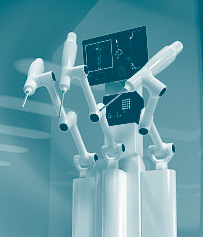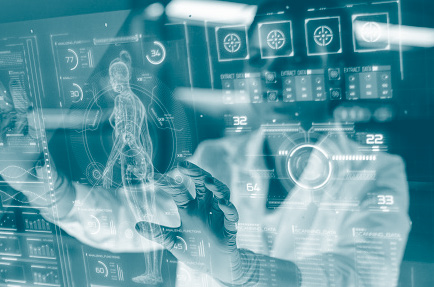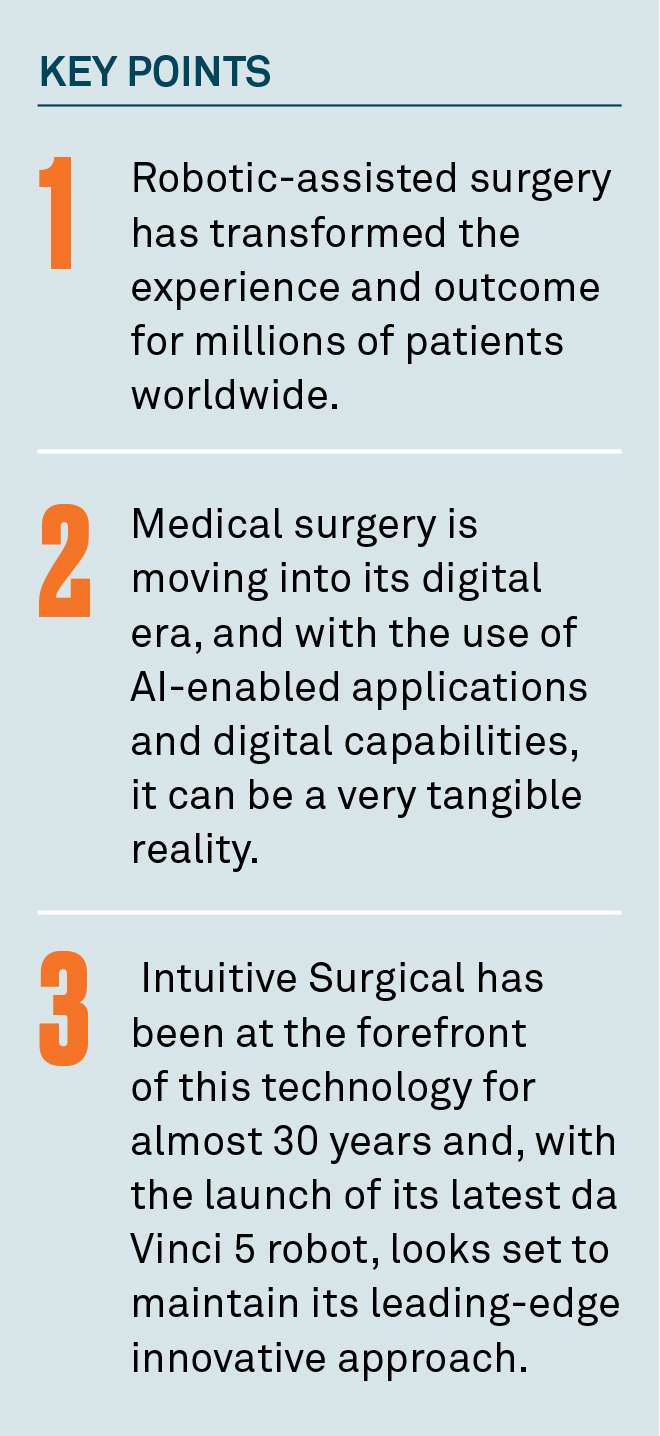July 2024
The concept of robotic-assisted surgery was first put forward in the late 1960s1 but took decades to be realized. Since then, the technology has transformed the experience and outcome for millions of patients worldwide. Intuitive Surgical (Intuitive) has been at the forefront of this technology for almost 30 years and, with the launch of its latest da Vinci 5 robot, looks set to maintain its leading-edge innovative approach.

There is a video on YouTube featuring a peeled grape being stitched back together by a surgical robot that has garnered almost 10 million views. The precision and delicate nature of the intricate procedure is remarkable and, arguably, far more palatable than watching one of the actual operations the device is designed to carry out. The robot is a da Vinci system, designed and manufactured by Intuitive Surgical, to perform minimally invasive surgery.
To go back in time, surgery wasn’t always “minimally invasive”. Indeed, 200 years ago, it was downright dangerous and excruciatingly painful. Mortality rates were high with many patients who lived to tell the tale subsequently dying of infection. Mercifully, there have been great medical advancements over the years with the likes of anesthetics, sterilization of equipment and antibiotics. However, even today, when it comes to surgery, there may be high complication rates, a huge disparity in surgical outcomes and poor access to quality care. The relatively recent technology involving robotics has the potential to make a meaningful difference.
Born out of Stanford Research Institute’s pioneering of telerobotic surgery for the US Army in the 1980s, Intuitive Surgical was established in 1995. Its first robotic prototype was given the name “Lenny” after Leonardo da Vinci and, in 2000, its da Vinci system received Food and Drug Administration (FDA) approval for use in various minimally invasive surgical procedures.
While the da Vinci robot has evolved over the past two and a half decades, each generation has shared some fundamental technology. There are three key components: the surgeon’s console where the practitioner controls the instruments using his hands and feet while viewing a high-definition 3D screen of the patient’s anatomy; the patient cart, which comprises the camera and three or four robotic arms which hold the instruments being controlled by the surgeon and, lastly, the vision cart which allows other operating room staff to view the procedure.

From a surgeon’s perspective, the combination of robotic arms that can be angled in all directions and dual cameras, whereby the patient’s anatomy is viewed in 3D, provides greater dexterity and visibility as well as more accurate control and precision of surgical instruments.
More importantly, Intuitive’s products have been shown to deliver better and more consistent surgical outcomes for patients, with faster recovery times and reduced complications, including reduced re-admission risks.
While it would be difficult to argue against better patient outcomes, there may be an encouraging economic story for hospitals too. Unsurprisingly, the robotic-assisted surgery option is not cheap but, as health systems appear to increasingly adopt a more value-based approach, and therefore consider direct and indirect costs of the surgical procedure, the all-in cost of using robots is in fact proving to be lower than the alternative.
Globally, there are around 300 million major surgeries performed every year.2 In 2023, da Vinci systems completed 2.2 million procedures in 71 countries.3 With such low adoption rates, the market opportunity is vast. According to Intuitive, robotic-assisted surgery could be approved for 21 million procedures as the technology may potentially become the standard level of care in more countries.
Given some of these numbers, it’s no surprise that Intuitive is a global leader in its field.4 The question at this juncture could be whether it can maintain its competitive edge. However, the company has already built an exceptionally strong competitive moat due to the unique ecosystem it’s built through its products, its training of more than 76,000 surgeons worldwide5 and the clinical evidence generated to support the use of robotic-assisted surgery.
Arguably, one of Intuitive’s greatest advantages over its peers is in the enormous amount of data it has accumulated over more than 25 years. This includes everything from the raw video feeds of surgeries performed to which instruments are used for what and for how long, as well as the movements of the instruments and camera over time, as and when a surgeon uses an instrument and the precise wrist angle of their hands. There is even data available on the interactions between instruments and the tissue. With more than 14.2 million procedures performed to date across the da Vinci systems currently in use,6 the number of possible data points are almost infinite.

As with other industries, medical surgery appears to be moving into its digital era, and with the use of artificial intelligence (AI) enabled applications and digital capabilities, it can be a very tangible reality. With its abundance of data, Intuitive is already leveraging this advantage within its digital tools. For example, on a new app called Iris, surgeons can use an AI-powered visualization tool to get an idea of a patient’s specific anatomy before a procedure, then use virtual-reality enabled simulator programs to hone their skills in advance.
The company has also recently developed the Intuitive Hub, a platform that allows surgeons to record procedures for training and development purposes. It’s possible to use telepresence for real-time observations and collaboration. I was lucky enough to witness an early version of this technology almost a decade ago. Visiting North Carolina, I watched an experienced surgeon in a hospital there walk a colleague, based in India, through a complex cancer surgery step by step.
Taking this idea to the next level, Intuitive’s vision is for every surgeon using a da Vinci system to have something akin to a digital copilot to observe and support them in their work. With enough data, management is confident that it will be possible to develop predictive insights into which choices of surgical technique tend to the linked to the best patient outcomes. With these insights, the computer can ‘observe’ a procedure taking place and offer specific feedback in real-time. This is where Intuitive’s very latest robot comes in. In February, when I visited the company’s headquarters in Sunnyvale, California, the da Vinci 5 had yet to receive FDA approval (which it has now) but there was palpable excitement about its potential. In addition to its 150 new design features, it has 10,000x the computing power of the previous model. With this very clear emphasis on its computational power and ability to harness the company’s decades of captured surgical data.
AI and machine may have become over-used terms in many other realms of life but there are few more tangible examples of how the technology can benefit people’s physical lives than this. A company like Intuitive’s historical data, and analysis thereof, should ultimately lead to better patient outcomes while potentially reducing costs for hospitals. Having been leading edge since its early days, these latest advances demonstrate the company’s capacity to rarely sit still. In the words of Intuitive’s long-standing CEO Gary Guthart, “The job is never done. Opportunities for improvement are decades long.”
1 National Library of Medicine
2 National Library of Medicine, “Prevention of Surgical Errors”, May 2023
3 Intuitive Corporate Overview 2024
4 Medical Device Network, “Robotic Surgical Systems Market Displaying Continued Growth”, October 2023
5 Intuitive Corporate Overview 2024
Artificial Intelligence (AI) is a branch of computer science that deals with the creation of intelligent machines that can perform tasks that typically require human intelligence.
All investments involve risk, including the possible loss of principal. Certain investments involve greater or unique risks that should be considered along with the objectives, fees, and expenses before investing.
Company information is mentioned only for informational purposes and should not be construed as investment or any other advice. The holdings listed should not be considered recommendations to buy or sell a security.
BNY Investments is one of the world’s leading investment management organizations, encompassing BNY’s affiliated investment management firms and global distribution companies. BNY, BNY Mellon and Bank of New York Mellon are the corporate brands of The Bank of New York Mellon Corporation and may be used to reference the corporation as a whole and/or its various subsidiaries generally.
This material has been provided for informational purposes only and should not be construed as investment advice or a recommendation of any particular investment product, strategy, investment manager or account arrangement, and should not serve as a primary basis for investment decisions.
Prospective investors should consult a legal, tax or financial professional in order to determine whether any investment product, strategy or service is appropriate for their particular circumstances. Views expressed are those of the author stated and do not reflect views of other managers or the firm overall. Views are current as of the date of this publication and subject to change.
The information is based on current market conditions, which will fluctuate and may be superseded by subsequent market events or for other reasons. References to specific securities, asset classes and financial markets are for illustrative purposes only and are not intended to be and should not be interpreted as recommendations. Information contained herein has been obtained from sources believed to be reliable, but not guaranteed. No part of this material may be reproduced in any form, or referred to in any other publication, without express written permission.
Walter Scott & Partners Limited (“Walter Scott”) is an investment management firm authorized and regulated in the United Kingdom by the Financial Conduct Authority in the conduct of investment business. Walter Scott is a subsidiary of The Bank of New York Mellon Corporation.
©2024 BNY Mellon Securities Corporation, distributor,240 Greenwich Street, 9th Floor, New York, NY 10286
MARK-552874-2024-05-29







